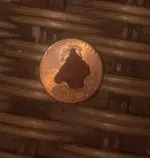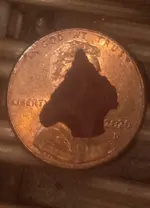You are using an out of date browser. It may not display this or other websites correctly.
You should upgrade or use an alternative browser.
You should upgrade or use an alternative browser.
🔎 UNIDENTIFIED Anyone know anything about this find?
- Thread starter Resakaye1321
- Start date
- Joined
- Jun 15, 2008
- Messages
- 36,017
- Reaction score
- 19,562
- Golden Thread
- 0
- Location
- Pennsylvania (USA)
- Primary Interest:
- All Treasure Hunting

Upvote
0
Please give more info when possible. I assume it’s stone, but could be iron as far as I can tell. The general category (if stone) is “bird point”. This can be somewhat of a misnomer as they were used for other small game as well.
Upvote
0
- Joined
- Jun 9, 2013
- Messages
- 7,486
- Reaction score
- 11,702
- Golden Thread
- 0
- Location
- Middle TN. area
- Detector(s) used
- White XLT Spectrum E-Series
- Primary Interest:
- Metal Detecting
Frogs, lizards, small snakes and small birds I'd guess. But its got to be a bitch working something that small...! I rather work a spear point any day over that.
Upvote
0
- Joined
- Dec 30, 2012
- Messages
- 10,503
- Reaction score
- 20,111
- Golden Thread
- 0
- Location
- Canton Ohio Area
- 🏆 Honorable Mentions:
- 2
- Detector(s) used
- Presently using Deus 2's & have Minelabs, Nokta's Tesoro's DEus's Have them all . Have WAY to many need to get rid of some
- Primary Interest:
- All Treasure Hunting
Why not put a regular penny next to it and take a picture of both so we can compare ?
Upvote
0
- Joined
- Jun 9, 2013
- Messages
- 7,486
- Reaction score
- 11,702
- Golden Thread
- 0
- Location
- Middle TN. area
- Detector(s) used
- White XLT Spectrum E-Series
- Primary Interest:
- Metal Detecting
I had no problem comparing it to the penny sitting on it. In fact it was a good idea since it fit easily onto the face of it.Why not put a regular penny next to it and take a picture of both so we can compare ?
Upvote
0
Resakaye1321
Jr. Member
- #8
Thread Owner
Yes it's stonePlease give more info when possible. I assume it’s stone, but could be iron as far as I can tell. The general category (if stone) is “bird point”. This can be somewhat of a misnomer as they were used for other small game as well.
Upvote
0
jewelerguy
Gold Member
Why not put a regular penny next to it and take a picture of both so we can compare ?




 looks like a regular penny to me
looks like a regular penny to me
Upvote
0
BAW
Full Member
- Joined
- Jul 19, 2020
- Messages
- 134
- Reaction score
- 439
- Golden Thread
- 0
- Primary Interest:
- All Treasure Hunting
Traditionally points this size are called “bird points “. Apparently the rationale is that one would use a small bullet to shoot birds so small points must be for birds as well. This was contradicted by Ishi, the last of the Yahi Indians, who said that large game was best taken with small points as they penetrated better.
When you consider that an arrow with no point at all would be sufficient to kill a bird, and take into account the difficulty of making tiny points and the number that the maker would break before he finished one, plus the fact that many of them are narrower than a normal, usable arrow shaft, I sometimes wonder if they were made by an expert arrowhead maker as a sort of tour-de-force, just to show that he could do it.
When you consider that an arrow with no point at all would be sufficient to kill a bird, and take into account the difficulty of making tiny points and the number that the maker would break before he finished one, plus the fact that many of them are narrower than a normal, usable arrow shaft, I sometimes wonder if they were made by an expert arrowhead maker as a sort of tour-de-force, just to show that he could do it.
Upvote
0
- Joined
- Dec 23, 2019
- Messages
- 6,570
- Reaction score
- 20,765
- Golden Thread
- 0
- Location
- Surrey, UK
- Primary Interest:
- All Treasure Hunting
Enough microlithic points have been found in association with kill sites of big game – including bison - to establish the likelihood that they were used to hunt large animals. Experimental archaeology has shown that points less than half inch in length are easily lethal enough to kill a deer or even a larger animal. They would certainly also have been effective in warfare. This video is very informative:
Stone point penetration test on a deer:
A better understanding of likely usage comes from a knowledge of archery and its technology. It’s all about arrow weight, bow-pull and penetration. A big point that fails to penetrate to the vital organs does less damage than a small point which pierces the heart or lungs.
The maximum penetration for a broad head comes from the use of an arrow weighing 12-14 grains per pound of bow-pull. Native American bows were generally slow versus modern compound bows, so we’re probably at the bottom end of the range. For a typical native bow with a 45lb pull, the best arrow weight would be about 540 grains. A wooden shaft could easily account for 450-500 grains and that then means you need a small point to compensate.
In areas where willow was used for bow-making the bows were generally D-shaped to prevent “overdrawing” and breakage, since willow is a fairly weak wood. A pull of around 30lb might be typical and that means lighter arrows were needed. This was achieved in part by either short-and-broad or longer-and-thinner arrowheads in combination with lightweight shafts. Reeds and the arrowweed stem (Pluchea sericea) were preferred materials and you could make a shaft weighing only about 200 grains. In areas where stronger wood such as juniper was available for bow-making, heavier arrowshafts with bigger heads could be used.
Also, after the horse became established among native tribes, the bow was generally shortened (the “horse bow”) and so was the arrow… again leading to the use of smaller points.
There are also accounts of tiny points in hollow reed shafts being used for close-range bow-hunting of duck and waterfowl (such as for the Lutuami or Klamath Lake Indians in southern Oregon). Hunters would float out on rafts made from reed bundles and lie in wait.
[Acknowledgement to: contributors Keith (Hummingbird Point) and Philip (philflintstone) on Palaeoplanet for very helpful information]
Also this, extracted from “A Theory on the Usage of Bird Points” by Mike Roper, Originally published in the Central States Archaeological Journal, Vol.56, No.2
“I have collected artifacts in the surrounding counties of Trussville, Alabama for the past fifty years. I have found many of the small projectiles that are commonly known as "bird points." Over the years I have developed a personal theory of how they were used.
Wherever we find them in Alabama we usually find more than just one. In some areas on the Coosa River, we have literally found hundreds. It is my opinion these points were actually used to kill birds when they were roosting. An example of such a bird would be the Passenger Pigeon, which were known to number in the millions in the mid 19th Century. History records that at one time flocks of these birds were so numerous they blocked the sun.
Hamilton and Madison points are late Mississippian projectiles that are known to be from the period when these birds were numerous. In the De Soto chronicles, there is mention that the Indians in the Alabama area utilized the small river cane for their arrows. This river cane is plentiful even today. If these "bird points" were mounted on a very small shaft, they could be inserted into the hollow cane arrow shaft. Then, if a cut were made several inches above the joint, this would allow the point with its small shaft to be inserted. It would bottom out on the joint below. If the bird point was mounted on a shaft six inches long this would allow it to extend out of the arrow shaft about three inches. These finished "darts" could then be shot into the roosting flock of birds. They would penetrate into the bird and the shaft to fall back to the ground. Then another dart could be placed into the end and then shot. This process could be repeated again and again with the hunter needing just a few arrows and a handful of darts.
Today, the massive flocks of birds are gone, the Passenger Pigeon extinct and the populations of many other species greatly diminished from what they were five hundred years ago. The Indians would have utilized these most convenient food sources, and most certainly would have had a practical way to hunt them."
Stone point penetration test on a deer:
A better understanding of likely usage comes from a knowledge of archery and its technology. It’s all about arrow weight, bow-pull and penetration. A big point that fails to penetrate to the vital organs does less damage than a small point which pierces the heart or lungs.
The maximum penetration for a broad head comes from the use of an arrow weighing 12-14 grains per pound of bow-pull. Native American bows were generally slow versus modern compound bows, so we’re probably at the bottom end of the range. For a typical native bow with a 45lb pull, the best arrow weight would be about 540 grains. A wooden shaft could easily account for 450-500 grains and that then means you need a small point to compensate.
In areas where willow was used for bow-making the bows were generally D-shaped to prevent “overdrawing” and breakage, since willow is a fairly weak wood. A pull of around 30lb might be typical and that means lighter arrows were needed. This was achieved in part by either short-and-broad or longer-and-thinner arrowheads in combination with lightweight shafts. Reeds and the arrowweed stem (Pluchea sericea) were preferred materials and you could make a shaft weighing only about 200 grains. In areas where stronger wood such as juniper was available for bow-making, heavier arrowshafts with bigger heads could be used.
Also, after the horse became established among native tribes, the bow was generally shortened (the “horse bow”) and so was the arrow… again leading to the use of smaller points.
There are also accounts of tiny points in hollow reed shafts being used for close-range bow-hunting of duck and waterfowl (such as for the Lutuami or Klamath Lake Indians in southern Oregon). Hunters would float out on rafts made from reed bundles and lie in wait.
[Acknowledgement to: contributors Keith (Hummingbird Point) and Philip (philflintstone) on Palaeoplanet for very helpful information]
Also this, extracted from “A Theory on the Usage of Bird Points” by Mike Roper, Originally published in the Central States Archaeological Journal, Vol.56, No.2
“I have collected artifacts in the surrounding counties of Trussville, Alabama for the past fifty years. I have found many of the small projectiles that are commonly known as "bird points." Over the years I have developed a personal theory of how they were used.
Wherever we find them in Alabama we usually find more than just one. In some areas on the Coosa River, we have literally found hundreds. It is my opinion these points were actually used to kill birds when they were roosting. An example of such a bird would be the Passenger Pigeon, which were known to number in the millions in the mid 19th Century. History records that at one time flocks of these birds were so numerous they blocked the sun.
Hamilton and Madison points are late Mississippian projectiles that are known to be from the period when these birds were numerous. In the De Soto chronicles, there is mention that the Indians in the Alabama area utilized the small river cane for their arrows. This river cane is plentiful even today. If these "bird points" were mounted on a very small shaft, they could be inserted into the hollow cane arrow shaft. Then, if a cut were made several inches above the joint, this would allow the point with its small shaft to be inserted. It would bottom out on the joint below. If the bird point was mounted on a shaft six inches long this would allow it to extend out of the arrow shaft about three inches. These finished "darts" could then be shot into the roosting flock of birds. They would penetrate into the bird and the shaft to fall back to the ground. Then another dart could be placed into the end and then shot. This process could be repeated again and again with the hunter needing just a few arrows and a handful of darts.
Today, the massive flocks of birds are gone, the Passenger Pigeon extinct and the populations of many other species greatly diminished from what they were five hundred years ago. The Indians would have utilized these most convenient food sources, and most certainly would have had a practical way to hunt them."
Upvote
0
Similar threads
Users who are viewing this thread
Total: 1 (members: 0, guests: 1)



